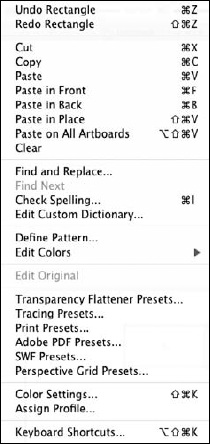In most programs, including Illustrator, many basic
functions of the Edit menu work the same way. If you've used the Edit
menu in Photoshop or Microsoft Word, for example, you should have no
trouble using the same functions in Illustrator because the menu options
are located in the same place in each program, as shown in Figure 1.

1. Using the Clear command
The most simplistic Edit
command is Clear. In Illustrator, it works almost exactly like Backspace
(Delete). When something is selected, choosing Clear eliminates what is
selected.
You're probably asking
yourself, "If Backspace (Delete) does the same thing, why do we need
Clear?" or "Why didn't they just call the Clear command Backspace
(Delete)?" Ah, the makers of Illustrator are a step ahead of you in this
respect. Note that I said "almost" the same way; there's a subtle yet
important difference in what the Clear command does and what Backspace
(Delete) does, due to Illustrator's abundant use of panels.
If you're working on a panel
and have just typed a value in an editable text field, Backspace
(Delete) deletes the last character typed. If you tabbed down or up to
an editable text field and highlighted text or if you dragged across
text in an editable text field and highlighted text, then Backspace
(Delete) deletes the highlighted characters. In all three situations,
the Clear command deletes anything that's selected in the document.
2. Cutting, copying, and pasting
The Cut, Copy, and Paste
commands in Illustrator are very handy. Copying and cutting selected
objects places them on the Clipboard, which is a temporary holding place
for objects that have been cut or copied. After you place an object on
the Clipboard, you can paste it in the center of the same document, the
same location as the cut or copied object, or another document, such as
Illustrator, InDesign, or Photoshop.
Choosing Cut from the Edit
menu deletes the selected objects and copies them to the Clipboard,
where they're stored until you cut or copy another object or until you
shut down or restart your computer. Quitting Illustrator doesn't remove
objects from the Clipboard.
Choosing Copy from the Edit
menu works like Cut, but it doesn't delete the selected objects.
Instead, it just copies them to the Clipboard, at which time you can
choose Paste and slap another copy into your document.
Choosing Paste from the Edit
menu places any objects on the Clipboard into the center of the document
window. Paste is not available if nothing is on the Clipboard.
|
Alternatively, you can use
the Paste in Front and Paste in Back options to position the object
you're pasting relative to other objects.
|
|
Now, here's the really cool
part: Just because you've pasted the object somewhere doesn't mean it
isn't on the Clipboard any more. It is! You can paste again and again —
and keep on pasting until you get bored or until your page is an
indecipherable mess, whichever comes first. The most important rule to
remember about Cut, Copy, and Paste is that whatever is currently on the
Clipboard is replaced by anything that subsequently gets cut or copied
to the Clipboard.
Cut, Copy, and Paste also
work with text that you type in a document. Using the Type tools, you
can select type, cut or copy it, and then paste it. When you're pasting
type, it goes wherever your blinking text cursor is located. If you have
type selected (highlighted) and you choose Paste, the type that was
selected is replaced by whatever you had on the Clipboard.
You can cut or copy as much or
as little of an illustration as you choose; you're limited only by your
hard drive space (which is used only if you run out of RAM).
|
If you ever get a message
saying you can't cut or copy because you're out of hard drive space,
it's time to start deleting stuff from your hard drive — or simply get a
bigger hard drive.
|
|
Thanks to the
Adobe PostScript capability on the Clipboard, Illustrator can copy paths
to other Adobe software, including InDesign and Photoshop. Paths
created in those packages (with the exception of InDesign) can be pasted
into Illustrator. With Photoshop, you have the option of pasting your
Clipboard contents as rasterized pixels instead of as paths.
You have the ability to drag
Illustrator artwork from an Illustrator document right into a Photoshop
document. In addition, because Adobe lets you move things in both
directions, you can drag a Photoshop selection from any Photoshop
document right into an Illustrator document.
3. Undoing and redoing
You can keep undoing in
Illustrator until you run out of either computer memory or patience.
After you undo a bunch of times, you can redo by choosing Redo a bunch
of times, which is found right below Undo in the Edit menu. And guess
what? You can redo everything you've undone. So, if you undo 20 times,
you can then immediately redo 20 times, and your art looks just like it
did before you started undoing.
Choosing Undo from the Edit
menu undoes the last activity that was performed in the document.
Successive undos undo more and more activities, until the document is at
the point where it was opened or created or you've run out of memory.
Choosing Redo from the Edit
menu redoes the last undo. You can continue to redo undos until you're
back to the point where you started undoing or you perform another
activity, at which time you can no longer redo any previous undos. You
have to undo the last thing you did and then actually do everything
again. In other words, all the steps that you undid are gone. It's fine
to use the Undo feature to go back and check out what you did, but after
you've used multiple undos, don't do anything if you want to redo back
to where you started undoing from. Got that?